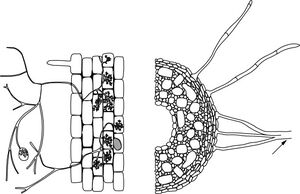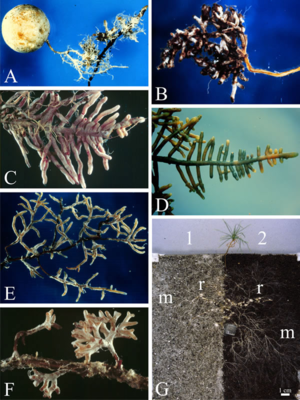Mycorrhizae
Mycorrhizae is a symbiotic association between plant roots and fungi. The formation of a mycorrhizal symbiosis is considered a widespread strategy of plants to obtain advantages under selection pressure in natural ecosystems. [1] The fungi in the soil which commonly form mycorrhizal relationships with plants are mostly unique. The relationships between the fungus and the plant are mutual beneficial: the fungus receives necessary carbohydrates from the host plant, and the mycorrhizae absorbs nutrients from the soil which are passed along to the plant in return. Mycorrhizae is one of the important set of survival mechanisms for plants living in challenging locations. [2] It also play a key role in terrestrial ecosystems to regulate nutrient and carbon cycles, and influence soil structure and ecosystem multifunctionality. [3]

Types
There are mainly two types of mycorrhizae based on morphology and physiology characteristics: Ectomycorrhizae and Endomycorrhizae.

Ectomycorrhizae
Ectomycorrhizae are characterized by the presence of a fungal mantle that envelops host roots and a Hartig net that surrounds root epidermal or cortical cells. It provides a large surface area for resource exchange. Hormonal interactions between plant and fungus lead to dramatically altered root architecture, such as the suppression of root hairs. The external component of Ectomycorrhizae associations consists of hyphae with cross walls that partition cellular components. These hyphae sometimes coalesce into rhizomorphs that attach the mycelium to serve in water uptake. [6]
Ectomycorrhizae (ECM) associations involve the most diverse category of myocrrhizae: more than 5,000 species of fungi (mainly Basidiomycetes) with a limited number of Ascomycetes and Zygomycetes. [7] Major groups of plants for ECM include most herbs, grasses and many trees, hornworts, and liverworts. There are approximately 200,000 number of plant species hosing Ectomycorrhize fungi. [8] The majority of ECM synthesizing fungi belong to the classes Basidiomycetes and Ascomycetes that form fruiting bodies like mushrooms, puffballs, coral fungi, toadstools, truffles, etc. [9] Ectomycorrhizae are more common in the temperate zones of the world comparing to the tropics. In the northern temperate regions, plants such as pine (Pinus), spruce (Picea), fir (Abies), poplar (Populus), willow (Salix), beech (Fagus), birch (Betula) and oak (Quercus) typify the Ectomycorrhizae association. In the southern hemisphere, Eucalyptus and Northofagus (Southern Beech) are important genera. In total, 140 genera in 43 plant families have been identified as forming Ectomycorrhizae. [10]
Endomycorrhizae
The fungi form structures within the cortical cells and also grow intercellularly. The membranes of the fungus and the plant are in direct contact with each other. There are several types of endomycorrhiza, the best known being arbuscular mycorrhiza (AM, formerly called vesicular-arbuscular mycorrhia (VAM)), ericoid and orchid mycorrhiza.
Plant-fungi Interactions
References
- ↑ Schönbeck,F., Grunewaldt-Stöcker, G. & von Alten, H. (1994). Mycorrhizae. In C. L. Campbell, D. M. (Eds.), Epidemiology and Management of Root Diseases Benson. Springer, Dordrecht.
- ↑ O’Callaghanm A.M. Mycorrhizae Fact Sheet. https://www2.nau.edu/~gaud/bio300/mycorrhizae.htm
- ↑ van der Heiden, M. G.A., Martin, F.M., Selosse, M., & Sanders, I.R. (2015). Mycorrhizal ecology and evolution: the past, the present, and the future. New Phytologist, 205(4), 1406-1423.
- ↑ Marschner, P. (2012). Rhizosphere Biology. In P. Marschner (Eds.), Marschner's Mineral Nutrition of Higher Plants (Thrid Edition). Academic Press. pp, 369-388.
- ↑ MMoore, D., Ectomycorrhizas. http://www.davidmoore.org.uk/assets/mostly_mycology/diane_howarth/ectomycorrhizas.htm
- ↑ Nancy, C., & Gehring, C. A. (2007). Mycorrhizas: Symbiotic Mediators of Rhizosphere and Ecosystem Processes. In Z.G.Cardon and J. L. Whitebeck (Eds.). The Rhizosphere. Academic Press.
- ↑ Futai, K., Taniguchi, T., Kataoka, R. (2008). Ectomycorrhizae and Their Importance in Forest Ecosystems. In: Siddiqui, Z.A., Akhtar, M.S., Futai, K. (eds) Mycorrhizae: Sustainable Agriculture and Forestry. Springer, Dordrecht.
- ↑ van der Heiden, M. G.A., Martin, F.M., Selosse, M., & Sanders, I.R. (2015). Mycorrhizal ecology and evolution: the past, the present, and the future. New Phytologist, 205(4), 1406-1423.
- ↑ Charya, L. S., & Garg, S. (2019). Advances in methods and practices of ectomycorrhizal research. In S. N. Meena and M. M. Nalk (Eds.). Advances in Biological Science Research. Academic Press.
- ↑ Moore, D., Ectomycorrhizas. http://www.davidmoore.org.uk/assets/mostly_mycology/diane_howarth/ectomycorrhizas.htm